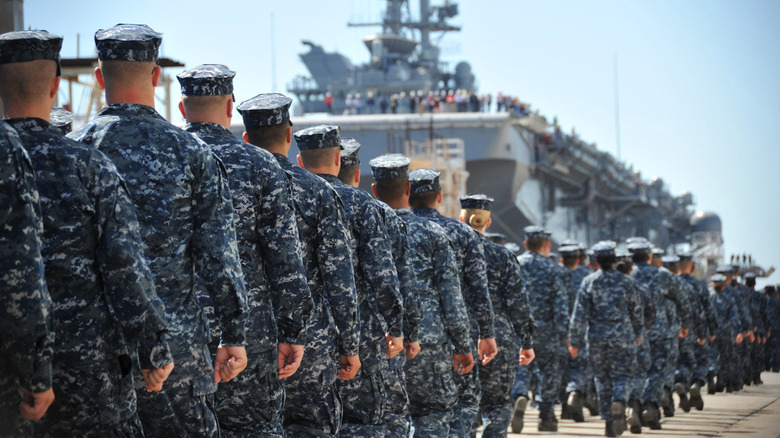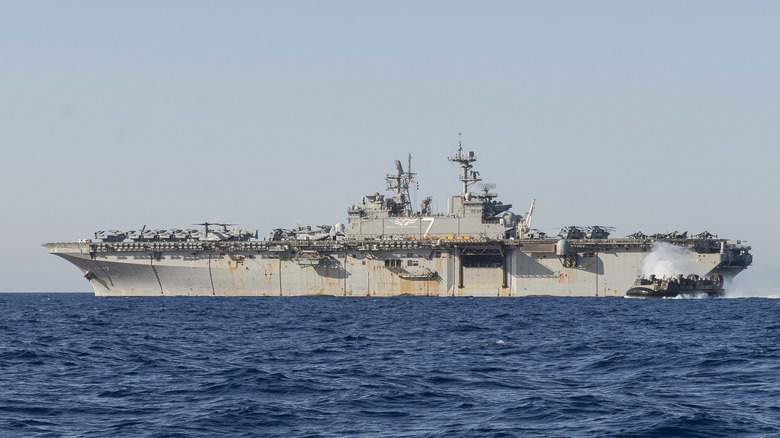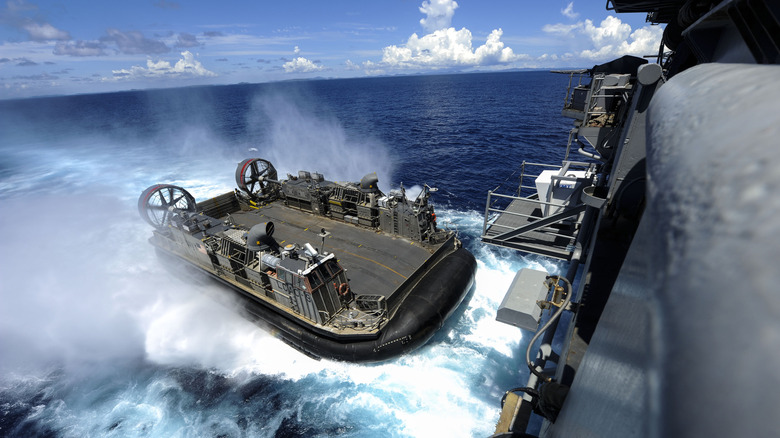Does The US Marine Corps Have Its Own Ships?
The United States Marine Corps is a well-trained amphibious force capable of executing operations in the air and on land. When it comes to the air, the Marine Corps has its own fighter jets, including one of the F-35 fighter jet variants. For many decades the Marine Corps even had tanks for its ground forces –it still has many other armored vehicles– but when it comes to the sea, the USMC has primarily relied on its brothers and sisters in the United States Navy. On, under, and above the water is their domain. There are few vessels that the USMC controls exclusively and none of them are large ships like an aircraft carrier or destroyer. Any ship Marines are aboard is operated by naval personnel.
The Marine Corps and Navy go hand-in-hand because the USMC falls under the Department of the Navy's purview, despite having its own command structure. Marines have bases all over the world, but when they travel it's with the help of the men and women in the Navy. Units throughout the Marines are trained to operate air and ground vehicles along with some amphibious vehicles that can get them from the water to land. That's not to say they're not aboard large ships regularly.
The large vessels Marines use are amphibious assault vessels that carry troops, aircraft, and vehicles like the Light Armored Vehicle (LAV) as well as the Amphibious Combat Vehicle (ACV). The USMC has access to 31 Amphibious Warfare Ships and 35 Medium Landing Ships to accomplish its missions.
Amphibious assault ships
The United States Marine Corps can be seen aboard two types of large vessels: Amphibious Command Ships and Amphibious Assault Ships. The Blue Ridge-class Amphibious Command ship gives Navy and USMC leaders an amphibious command base where they can coordinate with fleet commanders during operations. There are only two of these, the USS Blue Ridge and USS Mount Whitney. The amphibious assault ships, whether Tarawa, Wasp, or America-class, look like smaller aircraft carriers with flight decks where Vertical Take-Off and Landing aircraft can land and depart from but they're more favorable than full-sized carriers as they provide a means to get troops and vehicles from the sea to the shore.
The 844-foot Wasp-class amphibious assault ship carries a crew of up to 66 officers and 1,004 enlisted while still having room for a Marine detachment of 1,687 troops . The flight deck can hold roughly 30 aircraft (helicopters and jets) while five landing craft are held below. The Tarawa-class, on the other hand, is shorter at 820-feet long, but has the same beam of 106 feet. It carries a smaller crew of 82 officers and 882 enlisted while it can carry a larger detachment of 1,900 Marines. It holds just as many aircraft on its flight deck but can hold seven landing craft below deck.
The Tarawa-class vessels are in the process of being replaced by the newer America-class amphibious assault ship, which is the same size as its Wasp counterpart. It can hold up to 1,687 Marines ready to storm a beach.
The Marine Corps has access to smaller vessels too
The one craft used exclusively by the Marine Corps is the large landing craft on an air cushion. It only takes a crew of five to operate but can carry between 60 and 75 tons of personnel and equipment. It was an ideal vehicle to transport the M1 Abrams from the water to the beach when Marines still used main battle tanks. With a full load, it can exceed 40 knots in speed with its four Allied-Signal TF-40B gas turbines and travel up to 300 miles. The air cushion allows it to easily maneuver across land and water, making it an efficient transport vessel. Over 70% of the world's coastline is accessible to the landing craft.
The Marine Corps has its own special operations group known as Marine Force Recon. The members of Force Recon are trained in amphibious reconnaissance, ground reconnaissance, surveillance, battlespace shaping, and raids that support incoming Marine Divisions. In some ways they're like the Navy SEALs of the Marines, but most probably wouldn't approve of that comparison. To execute many of their missions, they'll use the Special Operations Craft – Riverine. It's a small vessel that can fit a crew of four along with eight commandos. It's the perfect craft to patrol rivers and littoral environments used by both the Navy and the Marines.
However, they're usually operated by Special Warfare Combatant-craft Crewmen, which fall under U.S. Navy command, not USMC. If it can't also make landfall, it's not owned by the Marines.


